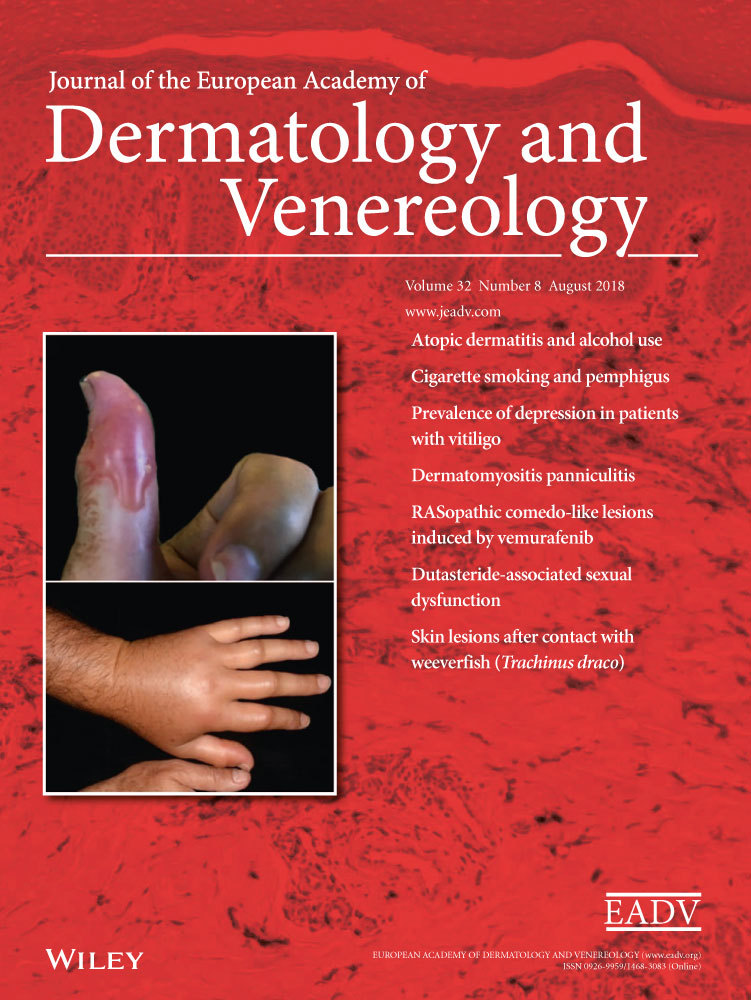Aryl hydrocarbon receptor signalling in the skin and adverse vemurafenib effects
Abstract
Linked article: This is a commentary on G. Kaya et al., pp. 1368–1372 in this issue. To view this article visit https://doi.org/10.1111/jdv.14945
The aryl hydrocarbon receptor (AhR) is a ligand-activated transcription factor which is expressed in all epidermal cells. Originally, this receptor was known to regulate the induction of several xenobiotica metabolizing enzymes of the Ah gene battery including genes of cytochrome P450 (CYP) of the 1A and 1B gene family, which play a major role in chemical carcinogenesis and other toxic effects by xenobiotic ligands of this receptor such as polycyclic hydrocarbons – e.g. benzo(a)pyrene – or halogenated hydrocarbons including several persistent organic pollutants (POPs) – e.g. 2,3,7,8-tetrachlorodibenzo-p-dioxin (TCDD).1 In the meantime, it ruled out that other ligands of this receptor such as kynurenine – an endogenous tryptophan metabolite – or 6-formylindolo[3,2-b]carbazole (FICZ) which is generated from the chromophore tryptophan under the influence of UV light.2 But also microorganisms of the skin microbiome – e.g. Malassezia strains – produce a number of tryptophane derivatives which are ligands of the AhR.3 On the other side, the AhR-dependent signalling pathway is connected with other signalling pathways such as the antioxidant response by Nrf2.4 Further on, the AhR interacts with several cytokines and growth factors including the epidermal growth factor depending signalling, TNF-α and TGF-β, and finally, the AhR is expressed also in immunocompetent cells such as antigen-presenting monocytes or macrophages as well as T lymphocytes, in particular in Th17-cells.4-7 Therefore, it ruled out that the AhR functions on the one side as a sensor not only for multiple exogenous chemical agents but also for UV light and the microbiome; on the other side, this receptor influences in the target organs such as the skin multiple physiological and pathophysiological processes, e.g. cell differentiation, apoptotic processes, inflammation or skin barrier formation.4 Therefore, the AhR also became an interesting target for new treatment options of skin diseases.8 However, one has to consider that the AhR-depending pathway can be regulated just by its own, leading to a canonical signalling. In this case, AhR is translocated to the nucleus after binding of a ligand. In the nucleus, AhR forms a heterodimer with ARNT and this AhR-ARNT dimer binds upstream of the AhR gene battery. Alternatively, the AhR can – as already mentioned – interact with several other pathways which may result in a noncanonical signalling in which not only genes of the AhR gene battery but also other genes are induced or even genes of the AhR gene battery are not induced or even inhibited.4 Therefore, it may be that the inhibition of AhR activity under the condition of the canonical signalling can be helpful to prevent carcinogenic processes or UV light depending damages; on the other side, it may be that the activation of AhR activity under the condition of a noncanonical signalling as in the case of inflammation, e.g. during psoriasis or eczema, is beneficial.9, 5
The ‘pioneering studies of Kimmig and Schultz who identified TCDD as a causative agent for chloracne’ – as Alan Poland stated in his review on TCDD poisoning – demonstrated that the skin is a signalling organ for intoxications by halogenated hydrocarbons.10, 11 Chloracne became one of the main diagnostic hallmarks and was further characterized by Saurat et al.12 as metabolizing acquired dioxin-induced skin hamartoma (MADISH). The exposure to halogenated hydrocarbons results in an activation of the AhR signalling, but also it has been shown that the Nrf2-depending signalling is involved that suggests that not only a canonical but also a noncanonical signalling can occur.13, 14
In this issue, Kaya et al. compared comedo-like or cystic lesions induced by the serine-/threoninekinase inhibitor vemurafenib with MADISH. Interestingly, they found that the lesions have several similarities; however, they differ with regard to the expression of CYP1A1 which is present in MADISH, but not in vemurafenib-induced lesions. They conclude from this observation that vemurafenib is inactive in inducing CYP1A1 and that therefore the vemurafenib-depending cysts are not a consequence of AhR activation.15 However, the complexity of the AhR signalling in particular with regard to a kinase inhibiting agent and the involvement of Nrf2 at least in MADISH formation opens the possibility of different conclusions which may also lead to new insights into possible cutaneous adverse drug reactions. Beside comedo-like or cystic lesions, vemurafenib induces also several cutaneous adverse effects accompanied by inflammation and it has been shown recently that vemurafenib inhibits the downstream signalling of the canonical pathway of AhR signalling which results in the induction of proinflammatory cytokines and chemokines.16 Binding studies with vemurafenib in the same study showed that it binds to the AhR and acts as an AhR antagonist – in opposite to TCDD, which is an agonist.16 The presentation of the differences of CYP induction between MADISH by an AhR agonist in opposite to the similar but not identical formation of comedo-like or cystic lesions by vemurafenib as an AhR antagonist by Kaya et al. in this issue together with further studies of the influence of inflammation, interacting of different pathways with the AhR-depending pathway under canonical or noncanonical regulation may lead finally to a better understanding of the AhR as a sensor of environmental stimuli.
Conflicts of interest
None declared.




